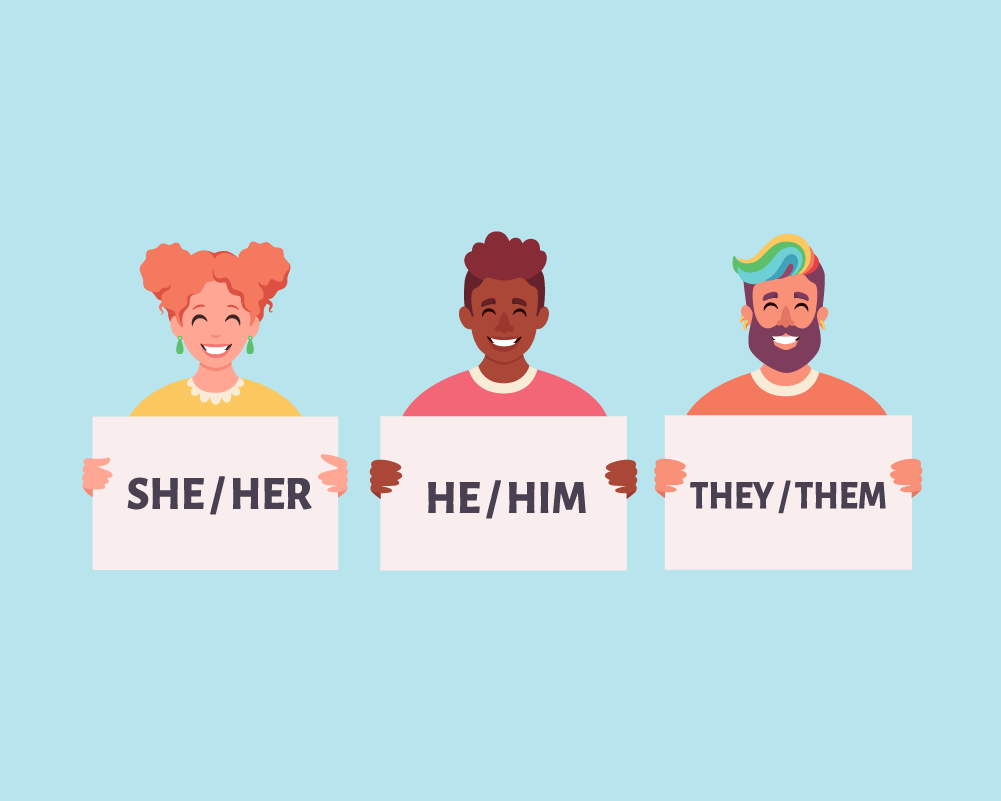After years of toil and dispute, LGBTQ advocates have managed to break the barriers of gender-focused language by introducing new non-binary terms and phrases and repurposing existing words and syntactic constructions.
In this article, we look at four language examples and how they express gender neutrality.
1. Gender neutrality in English: “They” as singular
Gender distinction is almost non-existent in English, except for the singular form pronoun when there is a need to assign a masculine or feminine gender, as the context requires. Well, that changed as of 2017 when the Associated Press introduced “they” as a singular form of the 3rd person singular pronoun in its Stylebook. Two years later, in 2019, the Meriam Webster dictionary also added “they” as the pronoun form to use for a “single person whose gender identity is nonbinary”.
Of note, the pronoun “they” and its possessive form “their” with a singular meaning can also be encountered in Shakespeare and Jane Austen’s works, among other well-known English-language authors, until Victorian scholars and grammarians imposed “he” and “his” for non-female references.
2. The Spanish example: inclusive case endings – “x” or “@”, “e”
Spanish clearly distinguishes between masculine and feminine nouns and pronouns. The definite article also changes form depending on the noun gender – el (masculine) or la (feminine). However, modern Spanish has introduced gender-neutral forms, such as “Latinx” or “Latin@”, frequently used in the US instead of “Latino” (masculine) or “Latina” (female).
In Argentina, teens have replaced the “standard” feminine and masculine endings with the gender-sensitive “e” – “Latine”, according to Samantha Schmidt, journalist at The Post. “Their efforts are at the center of a global debate over gender, amid the growing visibility of non-binary identities and a wave of feminist movements worldwide”, she noted.
The movement made waves in the Argentinian media in 2018 when Natalia Mira, a young activist, used gender-inclusive language in a public interview and was assaulted by a male journalist on the live broadcast.
Spanish is spoken in 20 countries across South and Central Americas, Equatorial Guinea in Africa and Spain in Europe. Given the diversity of its dialects, there are no set standards as to gender-neutral language use. Each nation or community uses its own rules, depending on preference.
3. The Arabic way: duality to express gender neutrality
Arabic is yet another grammatically gendered language, where verbs, nouns and adjectives change form depending on male/female gender. Male is the default gender in plurals, even if it’s the only male-gendered item in a female group.
Modern Arabic, relying on classical, Koranic language, has a dual alternative for verbs and nouns that are not gender-focused. Hence, some Arabic speakers prefer the dual of “they” and “you” “huma” (هما) and “intuma” (أنت), as a gender-pure alternative. Colloquial language has eliminated the dual, so for non-native speakers, these forms may sound very formal.
Others, for example, use masculine and feminine interchangeably to oust the supremacy of the male gender and patriarchal dominance (linguistically). Like Spanish, Arabic has many dialects, and each community has developed its own conventions and colloquial “rules”.
But how do you express notions such as “gay”, “bisexual”, or “transgender” in Arabic? Some resort to a transliteration of the English LGBTQ words, while others prefer to use the phrase “ mujtama’a al meem” (مجتمع الميم). After years of strife, militants of the LGBTQ community in Lebanon championed linguistic barriers, introducing the terms “mithly” (مثلي) and “mithliya” (مثلية) for “gay” as a standard widespread nowadays in the media and thus replacing the former Arabic equivalents of the English “deviant” or “pervert”.
However, gender inclusivity and tolerance for gender-neutral language is reduced in Arabic-speaking countries. It would probably take generations to change the mentality and idiosyncrasy around gender and sexuality.
4. Hebrew, a new linguistic perspective – neutral endings
Like Arabic, Hebrew distinguishes between noun genders and assigns a specific gender to verbs and adjectives, depending on the noun they determine. Hebrew gender-neutral language uses a feminine plural or a mixed gender, sometimes male, sometimes female for the same referent.
Nowadays, there are several ways of grammatically expressing gender neutrality and thus eliminating binary dissociation. For example, the Nonbinary Hebrew Project, an initiative of the gender neutrality activists in Israel and other Hebrew-speaking communities, has created a third gender in Hebrew, partly by exploiting non-binary references in classical Jewish texts, such as the Talmud and Torah. Male Rabbis writing the Mishna, a third-century Jewish commentary book, recognised multiple gender categories. Therefore, modern Hebrew speakers most likely can recognise the same.
One possibility to express gender inclusivity in Hebrew is to use both male and female genders on nouns and verbs, sometimes split by a period. For example, “I write” in Hebrew is expressed as “kotev” (כותב) in the masculine and “kotevet” (כותבת) in the feminine. If a gender-neutral form is preferred, then the same sentence would read as “kotev.et” (כותב.ת).
The western perspective
Western languages such as German and French, both grammatically gendered, have started applying gender neutrality in official contexts and paperwork. Germany, for example, has been using gender-neutral language in administration since 2014, when the Federal Ministry of Justice decreed that all institutions use gender-inclusive language. In its voting system, the term “wählende” (voting person) is preferred to “wähler” (male voter) or “wählerin” (female voter).
Comparatively, in France, the use of asterisks to express gender neutrality – “ami*e*s” (friends) – if the desire is to eliminate gender categorisation.
Since gender neutrality is here to stay, it may be worth doing a linguistic exercise, not just one of imagination, to attempt to accept it, don’t you think?
